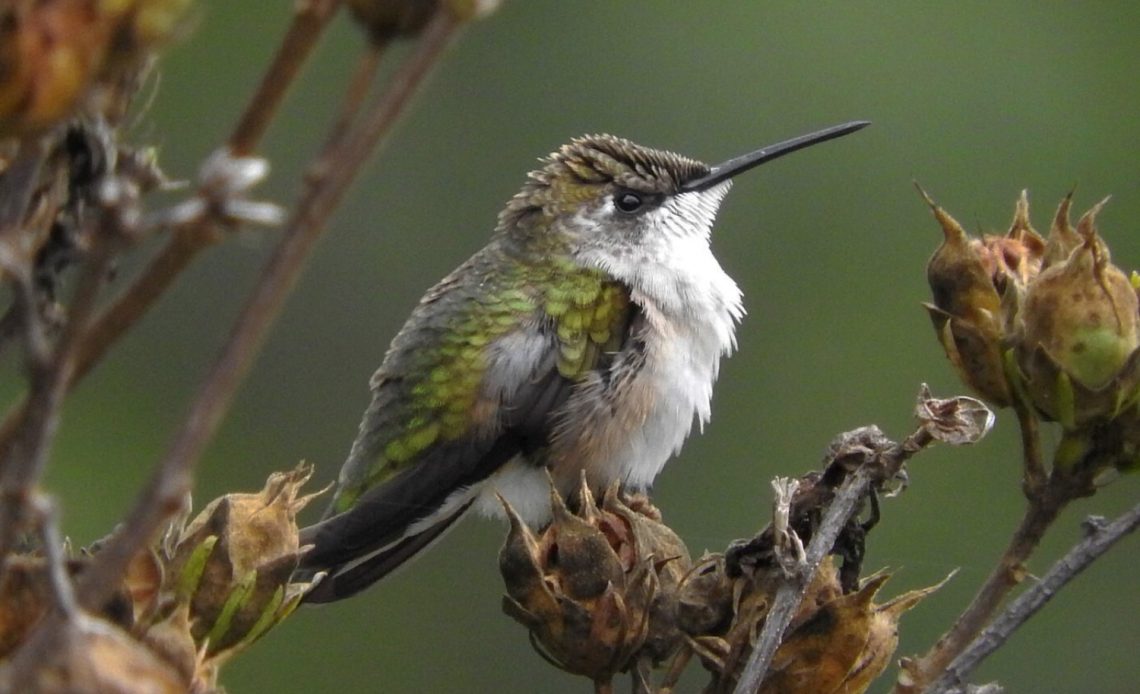

We’re here to help! Wild Yards is a completely free website that is 100% dedicated to helping you create a wildlife-friendly, sustainable yard. Read more
WildYards is reader-supported. When you buy a product through a link on our site, we may earn a comission. Every product is independently selected by our (obsessive) editors and our reviews are unbiased and objective. Read more about our mission or our privacy policy.
You don’t have to be a bird lover to enjoy seeing hummingbirds zip and zoom through your backyard. From the Plain-Capped Starthroat to the Blue-Throated Mountain Gem, these colorful fliers are a joy to watch. They make all of the hard work you spend tending to your pollinator garden worthwhile! Unfortunately, these beautiful little birds don’t live forever. If you find a hummingbird in distress in your garden, you may be wondering how to tell if a hummingbird is dying, and what you can do to help.
If a hummingbird is dying, it may appear disheveled with dull, ruffled plumage. You may notice a discharge from its eyes, nose, and mouth. It’s best to move a dying hummingbird to a calm, safe place and allow nature to run its course.
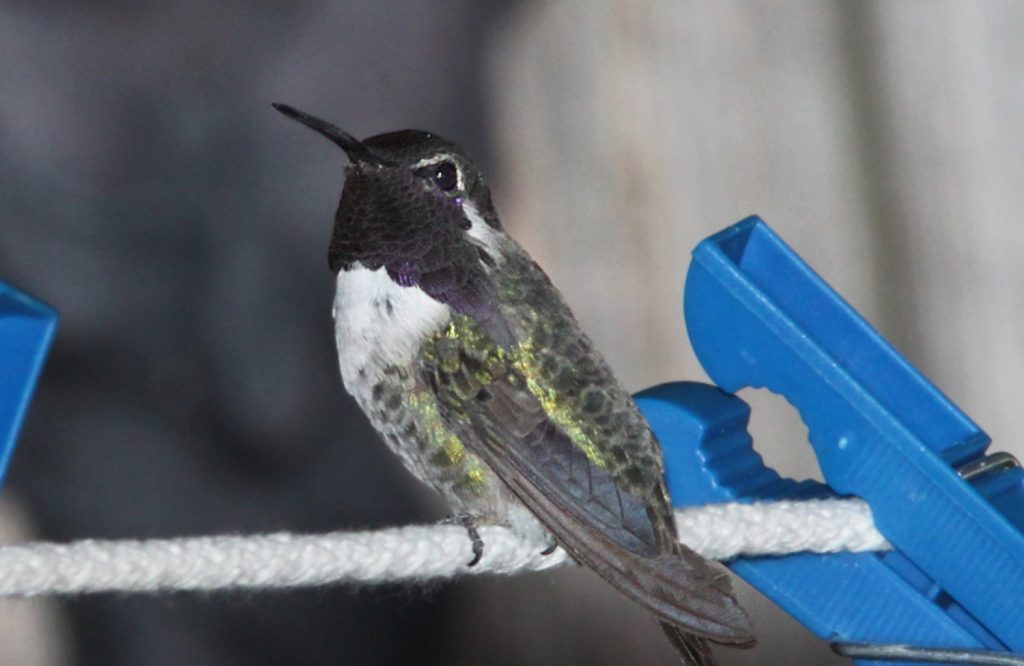
How long do hummingbirds live?
Although Ruby-throated hummingbirds have been known to live for more than 9 years, many hummingbirds don’t survive beyond their first year, succumbing to diseases, injuries, or predators.
In captivity, many hummingbirds live 10 years or longer. But in the wild, hummingbirds have short lifespans and live between 3 and 5 years on average.
If hummingbirds frequent your backyard year-round, or if they stop by during their yearly migration, there’s a good chance that you’ll encounter a dying hummingbird sooner or later. It’s the circle of life.
Many hummingbirds die from illnesses — either contagious viruses, like avian poxvirus, or bacterial and fungal infections, often caused by dirty hummingbird feeders.
Of course, there are things that you can do to prevent the spread of these diseases and keep your local hummingbird population as healthy as possible. We’ll get to those tips later on.
How to tell if a hummingbird is dying
You can usually tell just by looking at a hummingbird if something is wrong with it. If you want to know how to tell if a hummingbird is dying, the signs will be pretty obvious, even to the untrained eye.
The bird will likely be limp and have a disheveled appearance, with ruffled feathers that are dull and unkempt. The bird’s eyes may be closed or open and glossed over.
You may notice a discharge coming from the bird’s nose, eyes, or mouth. Dying hummingbirds also typically have abnormal breathing patterns, either slower or faster than normal. Some may breathe with their beaks open.
The hummingbird may appear listless and agitated. They may also appear emaciated. Certain diseases, like candidiasis, can prevent hummingbirds from feeding, leading to malnutrition, weight loss, and death.
Another red flag is if the hummingbird does not try to escape if you approach it, whether it’s on the ground, a branch, or a perch feeder.
Often, even exhausted or injured hummingbirds will attempt to escape from people and other predators. So if the bird doesn’t try to get away from you, or pay any attention to you at all, that’s another sign that it’s likely nearing the end of its life.
Now, sometimes, hummingbirds will hang upside down from perch feeders. This can be quite alarming, but it’s rarely a sign that the bird is dying.
Hummingbirds enter a half-sleep, half-hibernation state called torpor to conserve energy, lower their body temperature and heart rate, and rein in their metabolisms.
During torpor, many hummingbirds hang upside down. It’s a little unnerving at first glance, but it’s perfectly normal, and not a sign that the bird is near death.
Hummingbirds usually enter torpor at night when the temperatures drop below 50 degrees Fahrenheit. However, some birds may enter torpor on hot days, and they don’t necessarily hang upside down when doing so.
So if you see a hummingbird sitting on your feeder for hours, there’s no need to panic yet. Just keep an eye on it. It’s probably catching up on rest and will recover shortly.
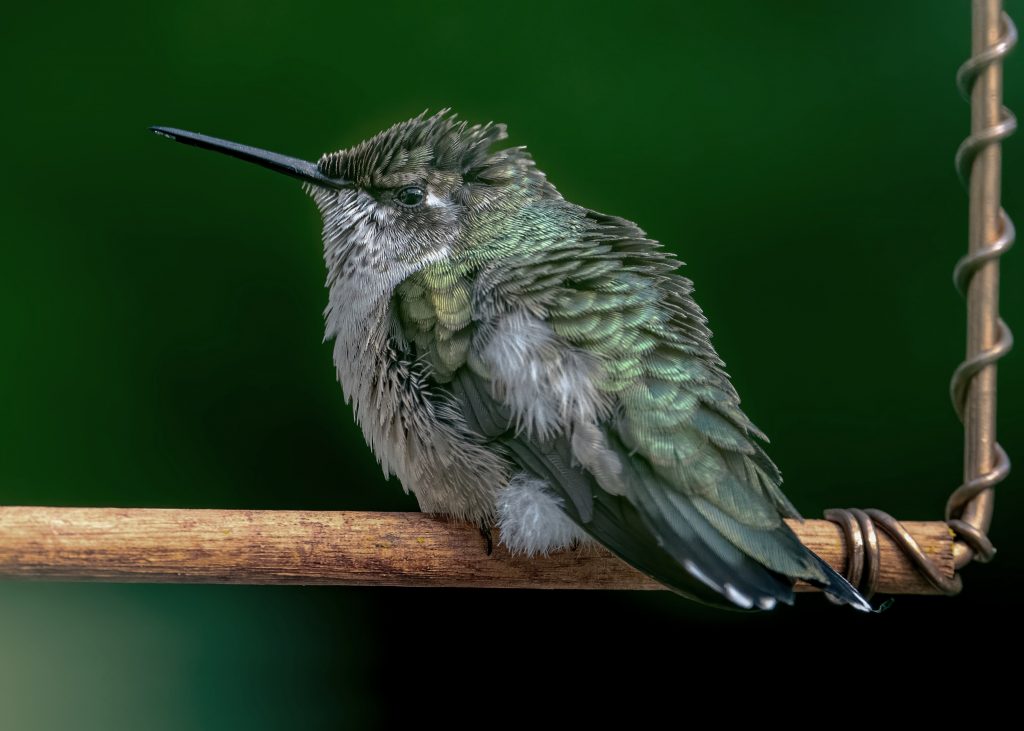
You found a hummingbird on the ground — now what?
If you’ve found a hummingbird on the ground in obvious distress, the question now is, is the bird dying, or can it be revived?
First, check for signs of injury. Is the hummingbird holding one of its wings out at an odd angle? Does it have ruffled feathers on its head or side, as if it flew into a wall?
If the hummingbird appears to be injured, contact a vet or a wildlife rescue for help.
Often, fledglings will fly into reflective surfaces, thinking that they’re actually chasing off other hummingbirds. These birds are usually disoriented, but they can recover with a little time. Move these birds to a quiet spot, or keep them in a shoe box for up to an hour to help them recuperate.
We’ve also found several hummingbirds on the ground not because they’re injured, but because they’re exhausted.
If this is the case, then the bird may appear to be sleeping. But, there’s also a chance that the bird will be responsive as you approach it. They may try to get away from you, or, at the very least, keep their eyes on you — even though you don’t want to do anything to deliberately scare the bird, this is usually a good sign.
Try offering the exhausted hummingbird an eyedropper full of homemade nectar. Don’t force the bird to drink it, but if it does, continue to offer the nectar. Once it’s had its fill, it may perk up and fly away.
If the hummingbird seems disinterested in the food, gently pick it up and place it in a shoebox lined with shredded paper or a soft towel. Cover the box and set it in a quiet, dimly-lit room for 15 minutes. If the hummingbird is exhausted, this will help it recover.
When the 15 minutes are up, take the box outside and open it. If the hummingbird has recovered, it will fly out and be A-OK. If not, repeat this process for up to an hour.
If, after an hour, the bird is still alert but showing no signs of improving, then get in touch with a local wildlife rescue for guidance.
On the other hand, if the bird has gotten worse after an hour has passed, then it is most likely dying. At this point, it’s best to keep the bird quiet and allow nature to run its course.
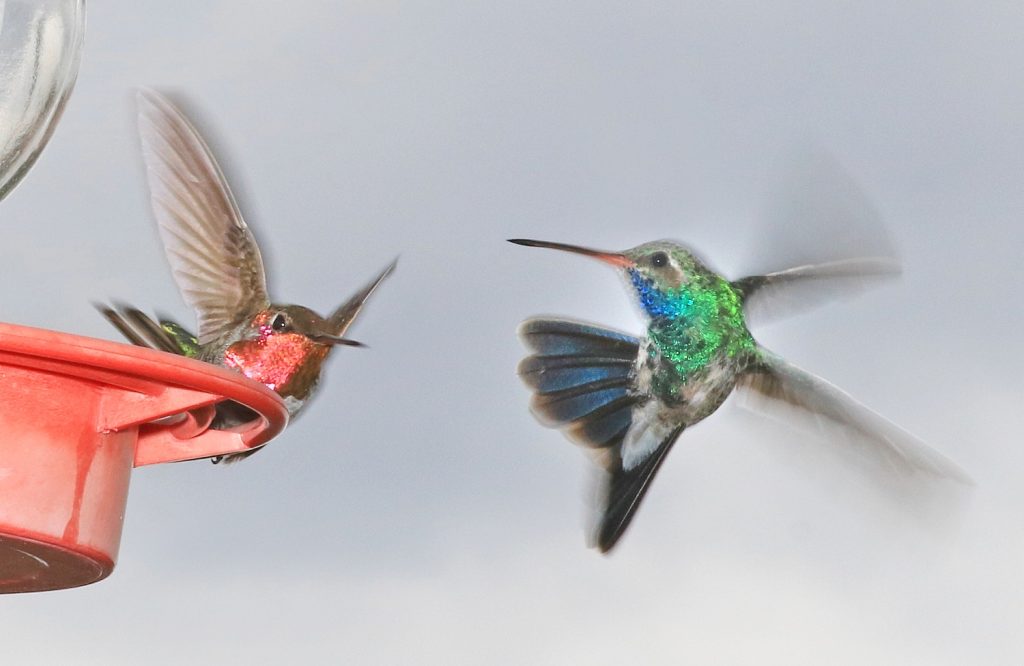
How to tell if a hummingbird is already dead
Hummingbirds are so small that it can be difficult to tell if they’re dying or if they’re already dead.
If you’ve found a hummingbird that appears to be lifeless, watch it closely for signs of breathing. Obviously, if the hummingbird is still drawing breath, it isn’t dead.
If you’re wondering how to tell if a hummingbird is dying, you can also observe the bird’s body temperature.
Both dead and dying hummingbirds can be limp, but dead hummingbirds are cold to the touch, while dying hummingbirds may still feel a bit warm.
If you’re still unsure whether or not a hummingbird is dead, move it onto a soft surface in a safe place and give it some time. Check back in about 10 minutes. If the bird’s condition hasn’t changed, it’s likely dead.
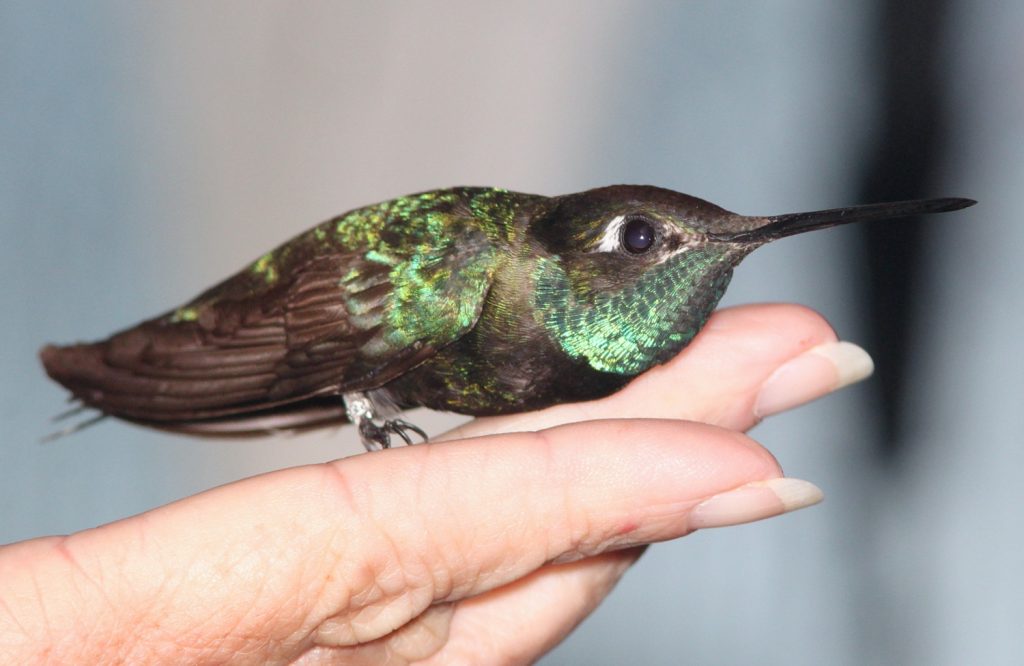
How to help a dying hummingbird
If you’ve found a hummingbird that you believe is dying, the best thing that you can do is try to make the hummingbird as comfortable as possible and simply leave it alone.
Move the hummingbird to a calm, secluded place in your garden where it won’t be disturbed by predators or other hummingbirds. Avoid repeatedly handling the hummingbird or even checking on it too often, as this may startle and upset it.
If you can’t find a quiet place outside, then line a shoebox with shredded paper or a clean towel, and place the bird inside of it. Set the box in a quiet, dimly lit area.
Keep pets away from the box, not only to keep the bird calm but also to prevent your pets from getting sick.
Be sure to check on the bird every 15 minutes by opening the box outside. Sometimes, exhausted hummingbirds get confused with dying hummingbirds. Leaving them alone to rest in a box gives them a chance to recuperate.
If you find a dying hummingbird, or if you try to revive a sick, injured, or exhausted hummingbird and it dies in the process, try not to take it too hard. It’s all a part of nature.
Understand that hummingbirds are notoriously difficult to revive, even by professionals and even in the best of circumstances.
Hummingbirds are flighty, fragile wild creatures that simply don’t bounce back well from extreme illness and/or stress. Although it may sound heartless, often the best thing that you can do for a dying hummingbird is nothing.
What should you do with a dead hummingbird?
If you’ve found a dead hummingbird, it’s best to bury it — especially if you believe the bird was sick, as this can help prevent the spread of a potentially fatal disease.
Avoid touching the hummingbird with your bare hands. Use a pair of disposable gloves if you must handle it. If possible, use a rake to move the dead bird onto a shovel, instead.
Bury the hummingbird at a depth of at least 8 inches. Backfill and tamp over the hole. If other critters like to visit your backyard, like armadillos, possums, and raccoons, you may need to set a stone over the hole so they can’t dig up the dead bird.
Wash your hands after burying the dead bird, and hose off your garden tools. Spray the tools down with a mixture of 1 part bleach to 10 parts water to sanitize them, then allow them to air dry.
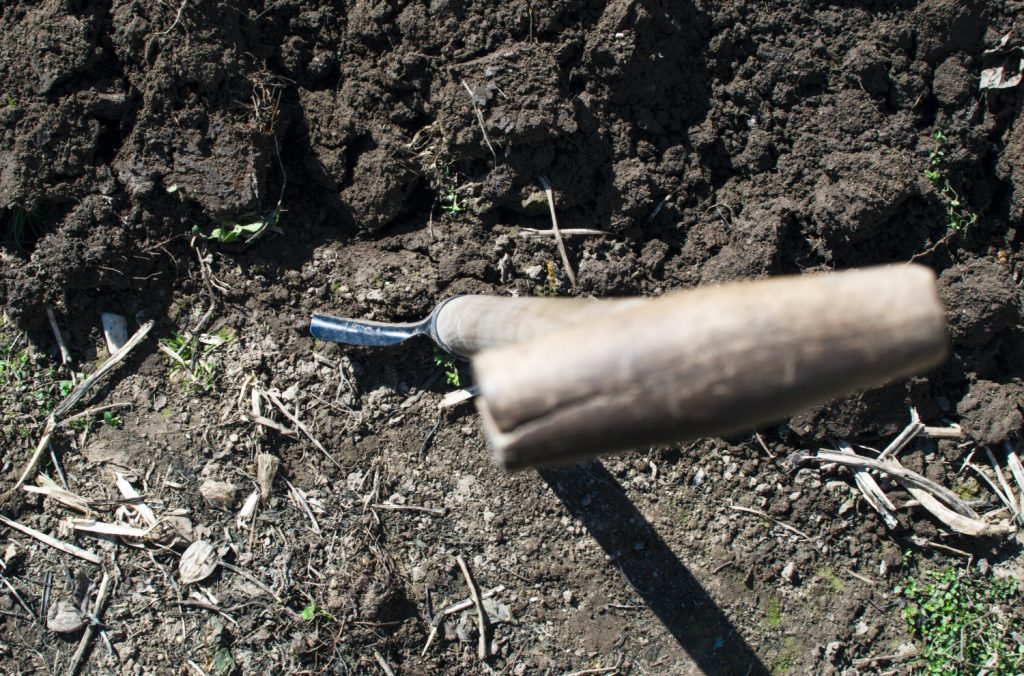
What can you do to help keep local hummingbirds healthy?
Knowing how to tell if a hummingbird is dying is helpful, especially if hummingbirds regularly visit your backyard.
But “dying hummingbirds” isn’t exactly an uplifting topic. So let’s switch gears here to something more action-oriented. What can you do to support your local hummingbirds so they can live long, healthy lives?
There are a number of things that you can do to make your backyard hummingbird-friendly!
Of course, installing feeders is a great way to help hummingbirds. But keeping those feeders clean is perhaps even more important. So be sure to wash your hummingbird feeders weekly with soap and rinse them in boiling water before refilling them with fresh homemade nectar.
Use only white sugar for your hummingbird water recipe. Honey, molasses, and other sweeteners ferment quickly, creating a breeding ground for deadly bacteria. Artificial sweeteners are also a no-go, as hummingbirds are incapable of digesting these substances.
Plant vibrant flowers like hibiscus, dipladenia, and clematis, in your garden. Hummingbirds love variety, so plant bell-shaped flowers and open-faced flowers, like daisies, to give them plenty of options to choose from.
Install a bird bath in your garden so they have a place to wash off. Hummingbirds love moving water, so invest in a solar-powered fountain for your bird bath to catch their attention.
You can also hang up hummingbird houses and nesting material holders, to encourage female hummingbirds to raise their babies in your backyard.
Remember, too, to place reflective decals on your windows so passing hummingbirds will refrain from flying into them. Placing a whirligig or windchimes in front of your windows may help, too.
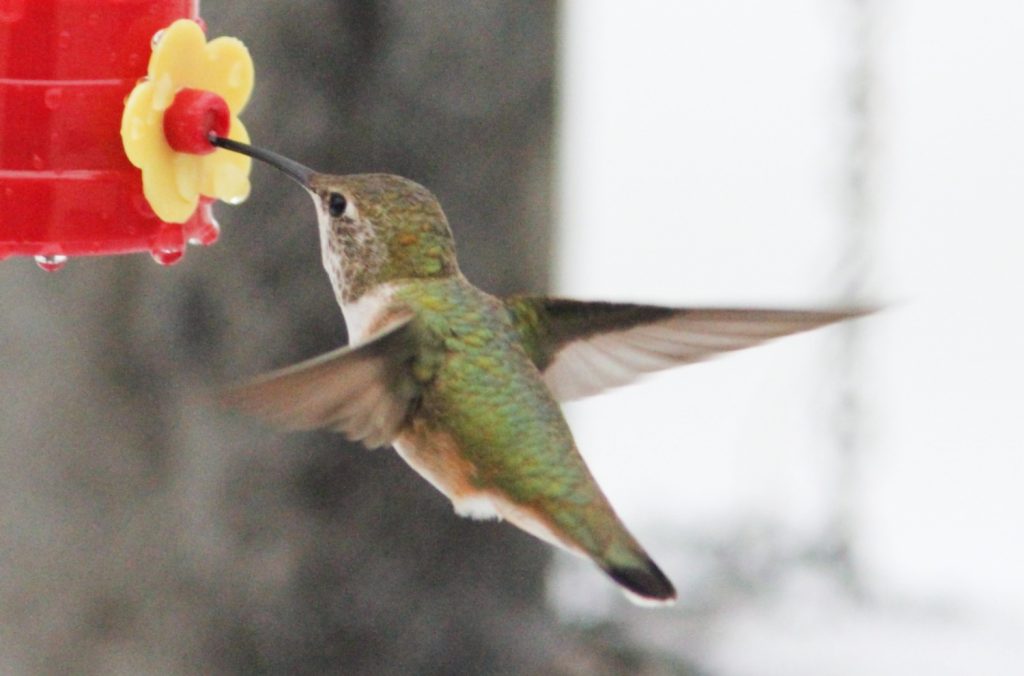
More tips for supporting your local hummingbirds
Creating a hummingbird-friendly space with the help of native plants, feeders, and nesting materials is a great start. But here are a few more tips for supporting your local hummingbirds.
Start by monitoring your feeders for predatory insects. Praying mantises and large spiders have been known to prey on hummingbirds. If you find these insects on or near your hummingbird feeders, rehome them in a different part of your garden.
Additionally, if you have outdoor cats, bring them indoors. Not only will this keep local hummingbirds safe, but it will keep your cats safe as well.
Owls, hawks, and other predatory birds sometimes like to hang out around hummingbird feeders looking for a meal. If your cat also happens to be lurking about, these raptors may decide to make a meal out of them, instead.
Knowing how to tell if a hummingbird is dying allows you to provide supportive care for these wild creatures in their final moments. And taking the time to create a hummingbird-friendly backyard allows you to enrich their lives for generations to come.
